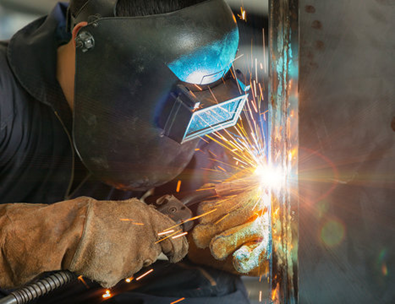Passing your 3G weld test is an important milestone in every welder’s career. Getting certified opens the door to a wide variety of welding jobs, and can make all the difference when you’re looking for work. This guide will cover everything you need to prepare for your test– including specifications, welding processes, and other handy tips and tricks, whether you’re working with stick welding, MIG, or FCAW.
Understanding the 3G Weld Test
The 3G weld test assesses your ability to weld vertically, which is often considered one of the more challenging orientations. The test uses plates, and may simulate on-job situations where vertical welding is essential. Here’s a summary of what to expect:
- Positioning: The plates are placed vertically, and you'll weld uphill or downhill to complete the joint.
- Testing Process: You’ll usually be required to weld a groove joint using a specified process, such as MIG (Metal Inert Gas), FCAW (Flux-Cored Arc Welding), or SMAW/stick welding (Shielded Metal Arc Welding). The weld is then inspected to test for any defects.
- Certification: Passing the test certifies you to weld in the 3G (vertical) position for groove and fillet welds, as well as flat and horizontal welds, allowing for a broader range of job opportunities.
Specifications
When preparing for the 3G weld test, understanding the specifications you’ll be working with is crucial. We recommend doing your research and contacting your testing facility so you can adequately prepare. However, here are some general guidelines for what to expect:
- Material Thickness: The plates used are typically around ⅜” for limited thickness, or 1” for unlimited thickness. You may need to adjust your technique based on material thickness.
- Welding Process: The test can be taken using various processes, including MIG, FCAW, and stick. Your choice of process may depend on the job you're applying for or the specific certification you need.
Welding Processes
Depending on your 3G weld test certification, you may be assessed in one or more different welding processes. SMAW/stick, MIG, and FCAW are among the most common.
Stick welding in the 3G position can be challenging. You’ll want to pay extra attention to manage slag, and remain completely in control of the electrode. Remember, you’re working against gravity.
- 7018 and 6010 electrodes are common choices for SMAW 3G weld tests. Depending on your test material, 7018 is a preferred, versatile rod used in structural welding because it's smooth and easy to weld with. However, many welders feel they get a cleaner and faster weld with 6010 rods, which are great for tacking. Be sure to practice and find what works best for you.
- Try your best to maintain a short, consistent arc length. This will help you to avoid undercutting, and prevent excessive spatter.
- You may have a preferred technique for vertical welds. Depending on the width between your plates, you may prefer stringers or weaves. Stringers can help welders be more precise, while weaving can cover a larger area.
MIG welding may be preferred due to its efficiency, but can still pose challenges in your 3G weld test.
- Be sure to fine-tune your voltage and wire speed. This is critical to reducing spatter, preventing a lack of fusion between plates, and maintaining complete control.
- Maintain a consistent travel speed. This will help you avoid defects such as undercutting and cold lap.
- Depending on the thickness of your metal, you may prefer the “push” or “pull” techniques. Pushing may help with thicker material, and leaves a more precise looking finished product. Pulling allows the pool to fill behind your electrode, which is often preferred for thinner metal.
FCAW welding is widely used in structural projects. It has a high deposition rate, and is often preferred for thick, durable metal.
- You’ll want to be diligent to maintain your slag. Be sure to clean your weld between passes to help avoid slag inclusions. However, some welders use their slag to their advantage for 3G welds, as it allows them to carry a larger puddle without weaving.
- Heat management is crucial when FCAW welding vertically. You’ll want to practice to see what temperature works best for you. You may also want to experiment with weaving to distribute the heat more evenly.
Tips and Tricks
- If you’re new to vertical welding, try working with thinner material first, and work your way up to thicker plates. In time, you’ll be better at controlling your weld pool in a 3G position.
- Manage your heat, speed, and positioning. Too much heat may cause burn-through or warping of the material, while too little can result in poor fusion of the metal. Experiment with varying your travel speed, angle of your rod, and adjusting your settings to find what works best for you.
- Consistency is crucial. Maintain a steady stance, control your arc length, and focus on making your weld as uniform as possible. Clean your weld between passes to ensure your fusion is strong and free of defects.
- Practice makes perfect. The best way to get ready for your 3G weld test is to prepare for your test in advance, and practice with the materials you’ll be using on test day. We recommend the AWS Test Kit 3/8", which includes five ⅜” × 7” × 4” beveled test plates and three backing bars.
Get Certified!
If you’re looking to advance your welding career, get certified with Triangle Engineering! Our team will walk you through the entire process, from scheduling your exam, giving you industry pointers, and discussing your test results with you. Our Certified Welding Inspectors (CWIs) on site always are eager to offer their tips and tricks to help you succeed.
We supply the equipment, materials, and space—you bring your gear and your expertise.
We offer tests Tuesday – Thursday. Contact us at (781) 878-1500 to schedule your test, or to request additional information.

